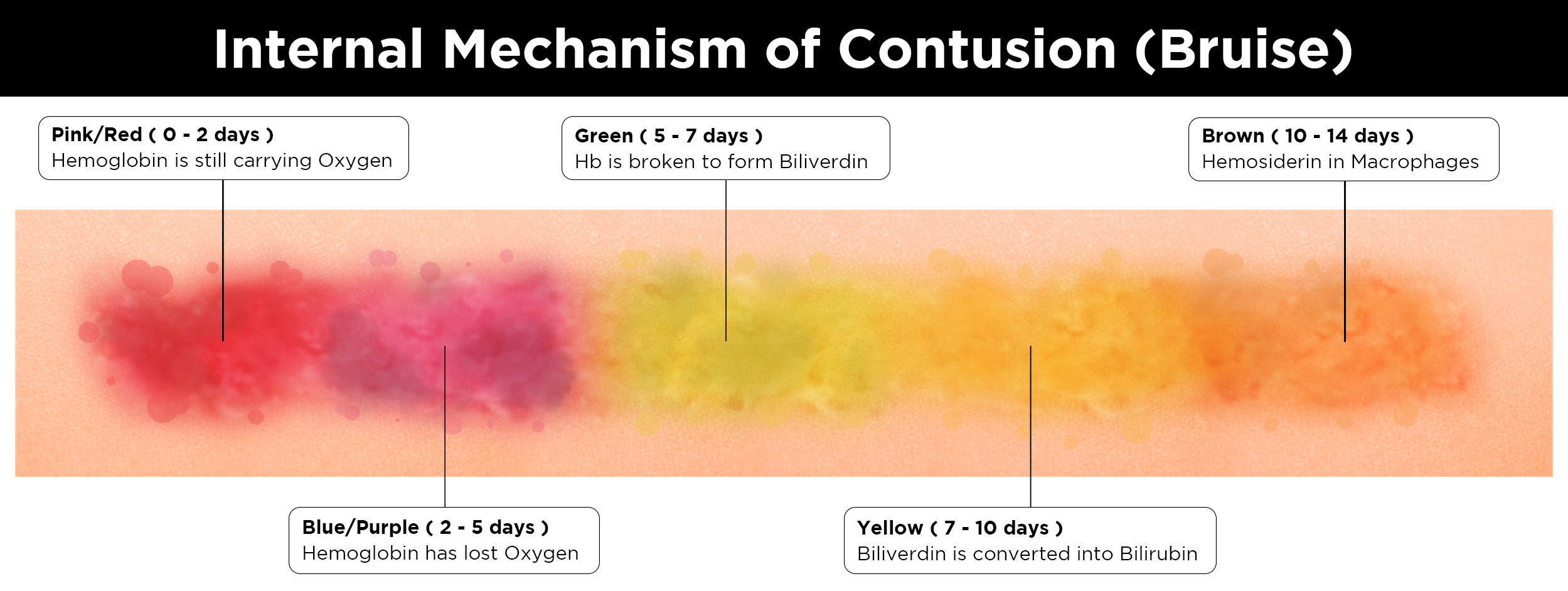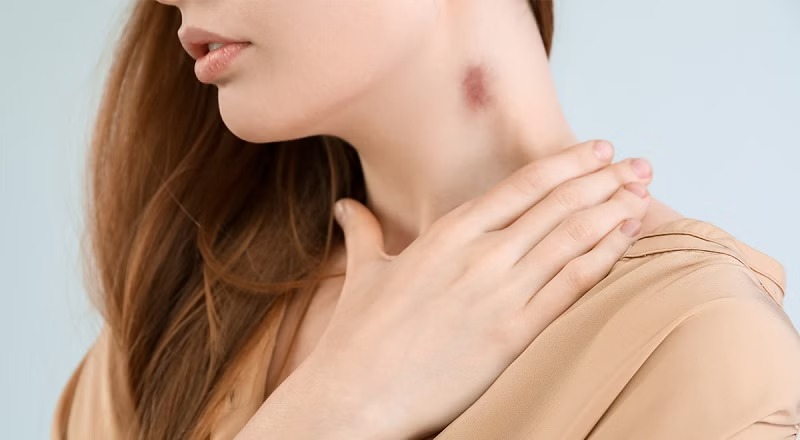A hickey, also known as a “love mark” or “kiss bruise,” is a small, visible bruise caused by suction or light pressure on the skin. Most often appearing on the neck, shoulders, or collarbone, hickeys are generally harmless but can be misunderstood or stigmatized. This comprehensive guide explores what causes hickeys, debunks common myths, outlines rare medical risks, and provides safe, practical methods for treatment and concealment.
What Is a Hickey?
A hickey is a type of superficial bruise. It forms when small blood vessels beneath the skin (capillaries) break due to suction or pressure. When these capillaries rupture, blood leaks into the surrounding tissue, creating a red, purple, or dark mark.
As the body naturally breaks down and reabsorbs the blood, the mark fades over time, similar to how other bruises heal. Hickeys do not involve broken skin and are typically painless, although they may feel tender at first.
What Causes a Hickey?
The primary cause of a hickey is suction applied to the skin, usually during close physical contact. The pressure pulls blood to the surface and ruptures small vessels.
Contributing Factors Include:
- Light biting or repeated pressure that increases trauma to the skin
- Delicate or sensitive skin, which is more prone to bruising
- Extended or forceful suction, which creates larger or darker hickeys
- Medical conditions such as anemia or blood clotting disorders that increase bruise susceptibility
How Long Does a Hickey Last?
Most hickeys heal within 3 to 14 days. The timeline varies based on skin type, severity of suction, and individual healing response.
Color progression often follows this pattern:
- Red or purple (days 1–3)
- Blue or greenish (days 4–7)
- Yellow or brown (days 8–14)
If a hickey remains after two weeks, becomes painful, or is accompanied by swelling or a lump, it’s advisable to consult a healthcare provider.

Are Hickeys Harmful?
Typically Harmless
In the vast majority of cases, hickeys are completely benign. They are a cosmetic issue and do not require medical attention.
Rare but Documented Risks
There are a few medically documented but extremely rare complications linked to hickeys:
1. Arterial injury and stroke:
A 2016 case in Mexico involved a 17-year-old who reportedly suffered a stroke possibly linked to a neck hickey near a major artery. Similarly, a 44-year-old woman in New Zealand developed stroke symptoms after receiving a hickey. These rare incidents suggest that excessive suction over certain areas of the neck could, in theory, trigger vascular damage. However, such cases are not common and are not definitive evidence of risk in healthy individuals.
2. Cold sore transmission (Herpes Simplex Virus 1):
If the person giving the hickey has an active cold sore, there is a small risk of transmitting HSV-1 to broken or irritated skin.
3. Skin damage or scarring:
Forceful suction, repeated hickeys in the same area, or picking at the bruise can occasionally lead to irritation or minor scarring.

How to Treat a Hickey
While there is no instant fix, several home remedies can help reduce the appearance and promote faster healing.
Cold Compress (First 24–48 Hours)
Apply a wrapped ice pack or a cold metal spoon to the area for 10–15 minutes at a time, several times daily. Cold treatment can minimize blood leakage and reduce swelling.
Warm Compress (After 48 Hours)
A warm compress promotes circulation, helping your body absorb the blood under the skin more efficiently. Use a warm (not hot) towel or heating pad for 10 minutes at a time.
Topical Treatments
- Arnica gel (20%): May reduce bruise severity and inflammation
- Vitamin K cream: Supports blood clotting and tissue healing
- Bromelain supplements or creams: An enzyme found in pineapple that may help reduce bruising
- Aloe vera and cocoa butter: Soothing and moisturizing, but not proven to speed up healing
What to Avoid
- Toothpaste: A widely shared myth with no scientific support. It can irritate the skin.
- Coins, toothbrushes, or rubbing: These can cause more damage, making the bruise worse or leading to broken skin.
How to Conceal a Hickey

If you want to cover up a hickey for personal or professional reasons, these strategies may help:
- Color-correcting makeup: Use a green concealer to neutralize red or purple tones, followed by a full-coverage concealer and setting powder
- High-collared clothing or scarves: Physically hide the mark without touching the skin
- Hair styling: Long hair or certain hairstyles can be used to shield the area
Avoid applying thick makeup if the skin is irritated or sensitive, and remove products gently to prevent additional irritation.
When to See a Doctor
Although most hickeys are harmless, you should seek medical advice if:
- The bruise lasts more than 14 days
- Pain, swelling, or a lump develops at the site
- You experience neurological symptoms such as numbness, dizziness, blurred vision, or difficulty speaking—these could be signs of a more serious underlying condition
How to Prevent Hickeys
- Use gentler suction or pressure, especially in sensitive areas like the neck
- Avoid creating hickeys near major arteries
- Refrain from any hickey-related activity if either person has an active cold sore
- Communicate clearly with your partner about boundaries and preferences

Hickeys vs. Other Bruises
| Feature | Hickeys | Common Bruises |
|---|---|---|
| Cause | Suction or mild biting | Blunt trauma or impact |
| Common location | Neck, collarbone, chest | Anywhere on the body |
| Appearance | Circular, red or purple | Irregular, varies in color and shape |
| Pain level | Usually painless | Can be painful, depending on severity |
Common Hickey Myths – Debunked
Myth: Toothpaste removes hickeys overnight
Fact: There is no scientific evidence to support this. Toothpaste can irritate or damage the skin.
Myth: Only teenagers get hickeys
Fact: Hickeys can occur at any age. Skin sensitivity and behavior are the determining factors.
Myth: Hickeys are a sign of love or commitment
Fact: While often associated with intimacy, a hickey is simply a physical result of suction or pressure on the skin.
Myth: Hickeys are dangerous
Fact: In almost all cases, hickeys are minor and heal on their own. Rare complications are documented but extremely unusual.
Conclusion
Hickeys are minor bruises caused by suction or pressure on the skin. While they may cause social discomfort or aesthetic concerns, they are typically harmless and resolve without intervention. Rare complications are possible but unlikely. Safe treatment methods, realistic expectations, and open communication can help manage or prevent hickeys effectively. Avoid harmful internet myths and focus on evidence-based care.
Sources
- Healthline: Can Hickeys Give You Cancer?
- Cleveland Clinic: How to Get Rid of a Hickey Fast
- WebMD: Hickeys – What You Need to Know
- Medical News Today: How to Get Rid of a Hickey
- Self: A Teen Died From a Stroke After a Hickey—Here’s What Doctors Say
- PubMed: Love Bite Resulting in Embolic Stroke
- GoodRx: 5 Fast Ways to Get Rid of a Hickey
- Greatist: Effective Hickey Treatments Backed by Dermatologists

